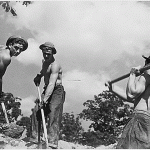 Our country exists for the people; not for the military-industrial complex, not for Wall Street speculators and banks. As soaring levels of unemployment appear to be with us for decades not years, the time is right. Troops get home, citizens have families; is a job too much to ask? We saved the banks, AIG, Goldman Sachs, Bank of America. Now, it’s our turn.
Our country exists for the people; not for the military-industrial complex, not for Wall Street speculators and banks. As soaring levels of unemployment appear to be with us for decades not years, the time is right. Troops get home, citizens have families; is a job too much to ask? We saved the banks, AIG, Goldman Sachs, Bank of America. Now, it’s our turn.
From WGBH – The American Experience:
The Civilian Conservation Corps (CCC); Watch the CCC Online
In March 1933, within weeks of his inauguration, President Franklin Roosevelt sent legislation to Congress aimed at providing relief for unemployed American workers. He proposed the Civilian Conservation Corps (CCC) to provide jobs in natural resource conservation. Over the next decade, the CCC put more than three million young men to work in the nation’s forests and parks, planting trees, building flood barriers, fighting fires, and maintaining roads and trails, conserving both private and federal land.
After a decade of national prosperity in the Roaring Twenties, Americans faced a national crisis after the Crash of 1929. The Great Depression saw an unemployment rate of more than twenty-five percent in the early 1930s. Inner-city crime rates soared, and the government did not have any specific plans to intervene. At the same time in the Midwest, the nine-year drought that would come to be known as the Dust Bowl was just beginning. Farmers struggled to hold on to their crops and their livestock as more precious topsoil blew away in windstorms every day.
The CCC was President Roosevelt’s answer to the environmental and economic challenges facing the country. Enlisting 250,000 workers in just two months, the CCC was an ambitious undertaking that brought several government agencies together in the effort. The Department of Labor recruited men from the ages of 18 to 25; the War Department clothed and trained them for two weeks, and the Department of Agriculture designed and managed the specific work assignments.
With projects in every U.S. state and territory, “Roosevelt’s Tree Army” lived in camps under quasi-military discipline, and received a wage of $30 per month, $25 of which they were required to send home to their families. Typically, boys rose early for breakfast in the canteen before heading off for eight hours of manual labor. Lunch was often brought out to the work site. In the evenings ninety percent of enrollees took advantage of classes offered in subjects from literature to welding — courses which, over nine years, taught 40,000 illiterate men to read and write.
After planting 3 billion trees in nine years of service, the CCC dissolved in July of 1942. As the economy began to improve in the late 1930s, young men found higher-paying jobs at home, and the number of CCC camps across the country dwindled. President Roosevelt’s attempt at turning it into a permanent agency failed. After the bombing of Pearl Harbor and subsequent U.S. involvement in World War II, the CCC’s funding and assets were diverted as the nation’s focus shifted toward the war effort. The legacy of the CCC continues to live on in the hundreds of campgrounds, hiking trails and swimming holes still enjoyed by Americans today.
In The Civilian Conservation Corps, four alumni Corpsmen share their experiences of poverty, racism, hard work and brotherhood from their time in the CCC. From Producer Robert Stone (Earth Days, Oswald’s Ghost), the film tells the tale of one of the boldest and most popular New Deal experiments.
ATTENTION READERS
We See The World From All Sides and Want YOU To Be Fully InformedIn fact, intentional disinformation is a disgraceful scourge in media today. So to assuage any possible errant incorrect information posted herein, we strongly encourage you to seek corroboration from other non-VT sources before forming an educated opinion.
About VT - Policies & Disclosures - Comment Policy



